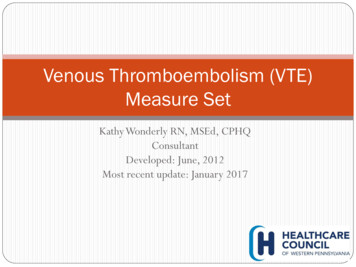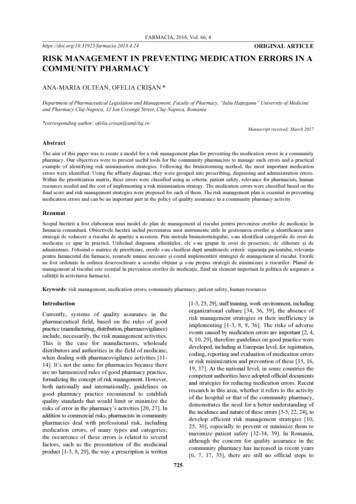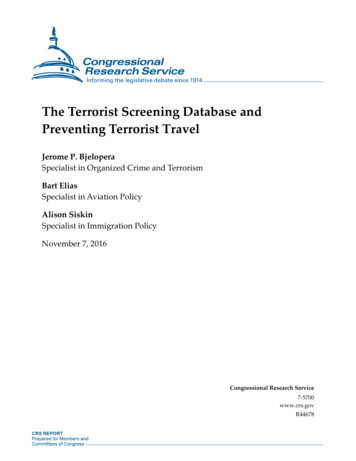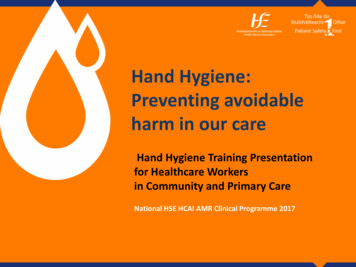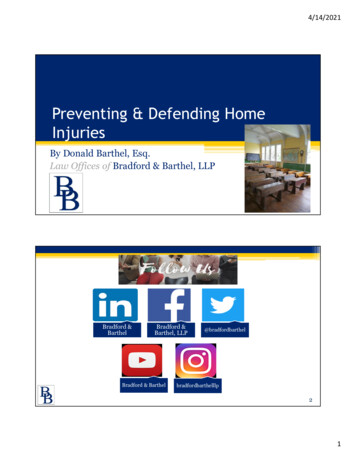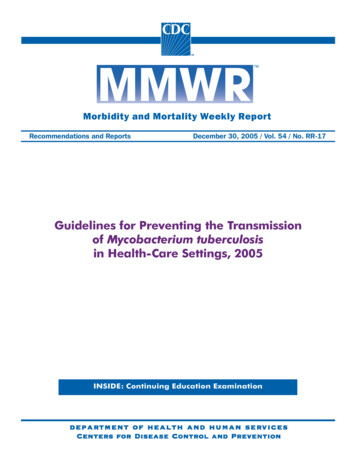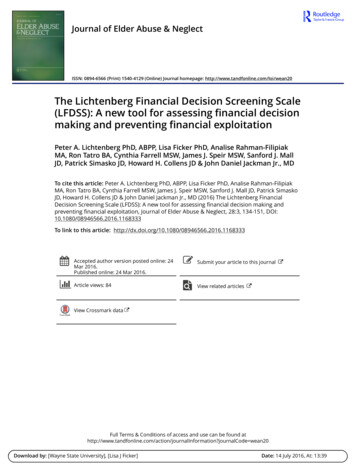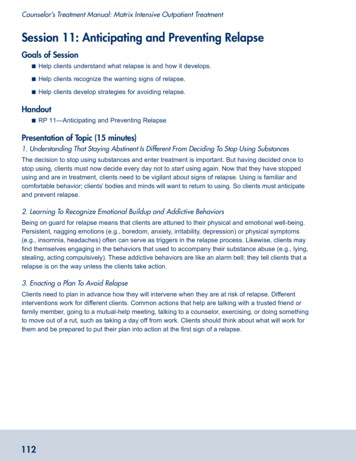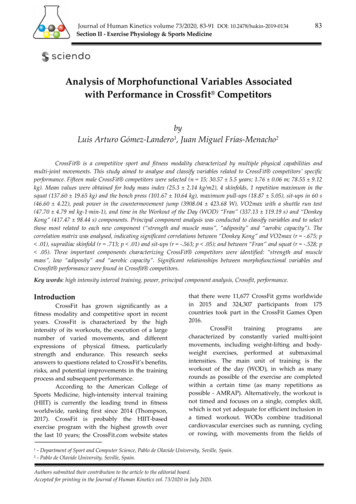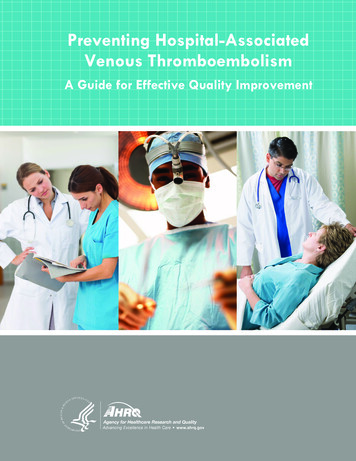
Transcription
Preventing Hospital-AssociatedVenous ThromboembolismA Guide for Effective Quality Improvement
Preventing Hospital-Associated VenousThromboembolismA Guide for Effective Quality ImprovementPrepared for:Agency for Healthcare Research and QualityU.S. Department of Health and Human Services540 Gaither RoadRockville, MD 20850www.ahrq.govPrepared by:Greg Maynard M.D., M.Sc., SFHMUniversity of California, San Diego Medical CenterDepartment of Medicine, Division of Hospital MedicineDirector, UCSD Center for Innovation and Improvement ScienceAHRQ Publication No. 16-0001-EFReplaces AHRQ Publication No. 08-0075Updated August 2016
The author discloses that he has acted as an expert in cases involving venous thromboembolism(VTE). Dr. Maynard also sits on an expert review panel for a phase 3 study on rivaroxaban forVTE prophylaxis in medical patients (Mariner study, Janssen Pharmaceuticals). He has no otheraffiliations or financial involvement (e.g., employment, consultancies, honoraria, stock options,grants, patents received or pending, or royalties) that conflict with material presented in this guide.This document is in the public domain and may be used and reprinted without specialpermission. Citation of the source is appreciated.Suggested CitationMaynard G. Preventing hospital-associated venous thromboembolism: a guide for effectivequality improvement, 2nd ed. Rockville, MD: Agency for Healthcare Research and Quality;August 2016. AHRQ Publication No. 16-0001-EF.ii
AcknowledgmentsThe author would like to acknowledge those who contributed to the first version of the guide,most notably Dr. Jason Stein of Emory University. Dr. Maynard has also been inspired by allthose who have engaged in collaborative improvement efforts using the previous version of thisguide; these have greatly informed this updated and revised version.In addition, many individuals contributed a great deal of their time and expertise to thedevelopment of the revised guide. For their expert input, the author gratefully acknowledges thefollowing individuals from the Centers for Disease Control and Prevention (CDC): Michele G. Beckman, M.P.H., Epidemiologist, National Center on Birth Defects andDevelopmental Disabilities;Scott Grosse, Ph.D., Research Economist, National Center on Birth Defects andDevelopmental Disabilities; andLisa C. Richardson, M.D., M.P.H., Director of Division of Cancer Prevention andControlFrom the Center for Quality Improvement and Patient Safety at AHRQ: Barbara Bartman, M.D., M.P.H., Medical Officer and AHRQ VTE clinical expertadvisor;Jeff Brady, M.D., M.P.H., Rear Admiral, U.S. Public Health Service and Director,CQuIPS;Eileen M. Hogan, M.P.A., Public Health Analyst.Finally, AHRQ and the author acknowledge the patients and families who have shared theirpersonal stories about the impact VTE had on their lives and their insights into the importance ofprevention efforts.Peer ReviewersBefore publication of the revised guide, AHRQ sought input from independent peer reviewerswithout financial conflicts of interest. Please note that the conclusions and information presentedin this guide do not necessarily represent the views of individual reviewers. The list of peerreviewers follows:Alpesh N. Amin, M.D.Chair, Department of Medicine; School of Medicine, University of California, IrvineIrvine, CADavid Garcia, M.D.Professor, University of Washington School of Medicine, University of WashingtonSeattle, WAiii
William Geerts, M.D.Affiliate Scientist, Sunnybrook Health Sciences CentreToronto, ONElliott Richard Haut, M.D., Ph.D.Fellowship Director, Trauma/Acute Care Surgery Fellowship and Associate Professor ofSurgery, The Johns Hopkins HospitalBaltimore, MDMichael Gould, M.D., M.S.Director for Health Services Research and Implementation Science, Kaiser Permanente SouthernCaliforniaPasadena, CAGary E. Raskob, Ph.D.Dean and Regents Professor, College of Public Health, The University of Oklahoma HealthSciences CenterOklahoma City, OKMichael Streiff, M.D.Medical Director, Anticoagulation Management Service and Outpatient Clinics and AssociateProfessor of Medicine, The Johns Hopkins HospitalBaltimore, MDRichard H. White, M.D.Chief of General Medicine and Professor of Medicine, University of California, DavisCenter for Healthcare Policy and Research, Lawrence J. Ellison Ambulatory Care Center,General MedicineSacramento, CANeil A. Zakai, M.D., M.Sc.Associate Professor of Medicine, Hematology/Oncology Division, Department of Medicine andAssociate Professor of Pathology and Laboratory MedicineUniversity of Vermont College of Medicine, Colchester Research FacilityColchester, VTiv
Table of ContentsPreface. viiHospital-Associated Venous Thromboembolism as a Public Health Problem . viiPurpose of This Guide. viiiWhat’s New in This Guide . ixHow To Use the Guide and Related Tools and Resources .xExecutive Summary .1Chapter 1. The Framework for Improvement .3Essential First Steps .4Stages of the Quality Improvement Effort .10Chapter 2. Analyze Care Delivery .12Identify Common Barriers to Improvement .12Identify Common Failure Modes .13Diagram Care Delivery To Identify Failure Modes .14Chapter 3. Outline the Evidence and Identify Best Practices .16Know What the Literature Says About the Risk of Venous Thromboembolisms and Measuresfor Prevention .16Putting It All Together—Next Steps .21Chapter 4. Choose the Model To Assess VTE and Bleeding Risk .23Overview—Major Categories and Characteristics of VTE Risk Assessment Models .24Chapter 5. Implement the VTE Prevention Protocol .35The Importance of Effective Implementation .35Five Principles for Effective Implementation in Clinical Decision Support .36Chapter 6. Track Performance with Metrics .41The Importance and Purpose of Measurement.41Categories of Measurement.41Metric Selection .44Summary of the Approach to Measurement .56Chapter 7. Layering Interventions and Moving Toward Excellence .57Reviewing the Basics—Order Set Design and Implementation .57Beyond the Basics—Addressing Failure Modes and Layering Interventions .57Achieving Measure-vention: Reaching Level 5 on the Hierarchy of Reliability.63Taking Measure-vention to the Next Level .66Chapter 8. Continue To Improve, Hold the Gains, and Spread the Results .67Maintain and Spread the Gains .68References .69Preface .69Chapter 1 .72Chapter 2 .73Chapter 3 .73Chapter 4 .74Chapter 5 .76Chapter 6 .77Chapter 7 .78v
FiguresFigure 1.1: Framework for Improving VTE Prevention .3Figure 2.1: Process Map of VTE Prophylaxis With Common Areas of Failure .15Figure 4.1: DVT Prophylaxis Orders .24Figure 4.2: Classic “3 Bucket” Model Derived From AT8 .26Figure 4.3: Updated “3 Bucket” Model In Use at UC San Diego .27Figure 4.4: Scoring and Recommended Prophylaxis . Error! Bookmark not defined.Figure 4.5: Padua Risk Assessment Model for Nonsurgical InpatientsError! Bookmark not defined.Figure 4.6: IMPROVE VTE Risk Model – 4 Factor Version (Risk Factors Available onAdmission) . Error! Bookmark not defined.Figure 4.7: IMPROVE VTE Risk Model – 7 Factor Version (Includes Risk Factors That MayDevelop During the Hospital Stay) . Error! Bookmark not defined.Figure 6.1: Outcomes Chain for HA-VTE .43Figure 6.2: Automated Version of a Stoplight Report .49Figure 6.3: Comparison of Tabular Data and Run Chart on Appropriate Prophylaxis (from UCSan Diego Medical Center) .54Figure 6.4: Run Chart of Prophylaxis Patterns .55Figure 6.5: SPC Chart of the Percentage of Patients With Adequate Prophylaxis .56Figure 7.1: Percentage of Ordered Subcutaneous Pharmacologic Prophylaxis Doses That WereNot Administered to Adult Inpatients .61Figure 7.2: Excerpt From Automated Measure-vention Screening Tool (Enhanced StoplightMethod) .65TablesTable 1.1: Hierarchy of Reliability .11Table 3.1: Major Guidelines Addressing VTE Prophylaxis .16Table 4.1: Characteristics of Four Empirically Derived Models for VTE Risk .32Table 4.2: Bleeding Risk Factors and Conditions To Consider With Pharmacologic VTEProphylaxis.34Table 6.1: National Hospital Inpatient Quality Measures for VTE Prevention and Management 44Table 7.1: Common Failure Modes in Providing Optimal VTE Prophylaxis and Strategies andSolutions To Address Them .58Table 8.1: Advantages of Plan-Do-Study-Act and Principles for Success .67vi
PrefaceHospital-Associated Venous Thromboembolism as a Public HealthProblemPulmonary embolism (PE) and deep vein thrombosis (DVT), collectively known as venousthromboembolism (VTE), represent a major public health problem that affects 350,000 to600,000 Americans annually.1 Estimates vary widely, but the overall annual prevalence may beincreasing.2 VTE is primarily a problem of sick or injured patients who are hospitalized or wererecently hospitalized,3,4 and it is frequently estimated to be among the most common preventablecauses of hospital death.5-7Symptomatic DVT and PE are associated with extended duration of inpatient stays and high (1015 percent) fatality rates. VTE generally requires therapeutic anticoagulation for a minimum of 3months.8,9 This therapeutic anticoagulation is associated with 1 to 2 percent major bleeding perpatient year, resulting in fatal bleeding at least 0.1 to 0.3 percent per patient year in clinical trials.In real-world practices, the rates are much higher.10-12When patients survive the VTE event and acute course of anticoagulant therapy—and all theinconvenience, anxiety, and cost that represents—they are still at risk for other complications.More than 20 percent of patients with proximal DVT/PE will suffer a recurrent event onceanticoagulation has been discontinued, along with all the readmissions, mortality, and morbidityrisk that entails.13 Furthermore, 30 to 50 percent of DVT patients will develop postthromboticsyndrome,14 and an estimated 4 percent of PE patients will develop chronic thromboembolicpulmonary hypertension.15 Patients and their families relay powerful personal stories related toloss of function, difficulty with anticoagulant therapy, fiscal burden, and fear of recurrence.Thromboprophylaxis for at-risk inpatients can reduce VTE by 30 to 65 percent, has a lowincidence of major bleeding complications, and has well-documented cost-effectiveness.16,17Numerous guidelines from authoritative bodies outlining appropriate use of thromboprophylaxisare available,16,18-24 yet study after study reflects unacceptably low rates of thromboprophylaxisin patients at risk.25-30 For example, a recent cross-sectional international study of almost 70,000patients in 358 hospitals found that appropriate prophylaxis was administered in only 58.5percent of surgical and 39.5 percent of medical inpatients at risk for VTE27; another U.S. registryfound only 42 percent of patients with hospital-associated DVT received prophylaxis within 30days prior to diagnosis.30 This constellation of facts presents a powerful imperative forimprovement.This “implementation gap” in VTE prophylaxis between evidence-based best practice and actualpractice in the real world has not gone unnoticed as a major opportunity for improvement. In2008, the U.S. Surgeon General produced a call-to-action document for VTE prevention.1 Inaddition, key goals for VTE prevention are in place from the National Quality Forum and theJoint Commission,31,32 mirrored by criteria for meaningful use criteria for electronic healthrecords. The Surgical Care Improvement Project has widely used measures for VTEprevention,33 and VTE Prevention is one of the focus areas of the Partnership for Patients, amajor effort from the Centers for Medicare & Medicaid Services (CMS) to foster acceleratedimprovement.34vii
Reports commissioned by the Agency for Healthcare Research and Quality (AHRQ) calledthromboprophylaxis the “number one” patient safety practice,17 and a 2013 update continues tolist improved prophylaxis for VTE as a top 10 patient safety strategy to act on now.35 TheAmerican Public Health Association has stated that the “disconnect between evidence andexecution as it relates to DVT prevention amounts to a public health crisis.”36Purpose of This GuideIn 2008, AHRQ published Preventing Hospital-Acquired Venous Thromboembolism: A Guidefor Effective Quality Improvement.37 That guide was based on success in VTE prevention38-41 andquality improvement principles at the University of California, San Diego. The purpose of thatpublication and this update is to assist hospital improvement teams to close the implementationgap as effectively and efficiently as possible.While guidelines often focus on defining best practice, this work focuses on the specifics of howto ensure those best practices are reliably delivered in your local inpatient environment. Multiplebarriers and “failure modes” must be overcome to reliably provide prophylaxis to those at riskwhile avoiding over-prophylaxis of those who are not.It turns out that VTE prophylaxis is a somewhat complex process in the very complex hospitalenvironment. As systems, hospitals are perfectly designed to achieve the results they attain;improving care generally involves changing the basic design of elements of that system andcarefully monitoring to adjust the interventions and ensure that the change leads to the desiredimprovement. The basic principles and essential elements to reach breakthrough levels ofimprovement in care have not changed since they were listed in the first edition: Institutional support and prioritization for the initiative, expressed in terms of ameaningful investment in time, equipment, personnel, and informatics, and a sharing ofinstitutional improvement experience and resources to support any project needs.A multidisciplinary team or steering committee focused on reaching VTE prophylaxistargets and reporting to key medical staff committees.Reliable data collection and performance tracking.Specific goals or aims that are ambitious, time defined, and measurable.A proven quality improvement (QI) framework to coordinate steps toward breakthroughimprovement.Evidence-based protocols that standardize VTE risk assessment and prophylaxis.Institutional infrastructure, policies, practices, and educational programs that promote useof the protocol.The protocol that standardizes VTE risk assessment is so fundamental that it should not merelyexist but also be embedded in patient care. High-reliability design may then be used to enhanceeffective implementation.viii
What’s New in This GuideThis revision reflects important changes in the environment, new guidelines, and lessons learned.More specifically, this version presents:1. Lessons from collaboratives and success stories: The first edition of this guide wasused as the centerpiece of a number of multisite collaborative improvement effortsfunded by AHRQ. This experience in a wide variety of hospitals has provided insight intowhat works and, perhaps just as important, what does not work in real-world settings.42,43Many others have also published or shared o
Pulmonary embolism (PE) and deep vein thrombosis (DVT), collectively known as venous thromboembolism (VTE), represent a major public health problem that affects 350,000 to 600,000 Americans annually.1 Estima
